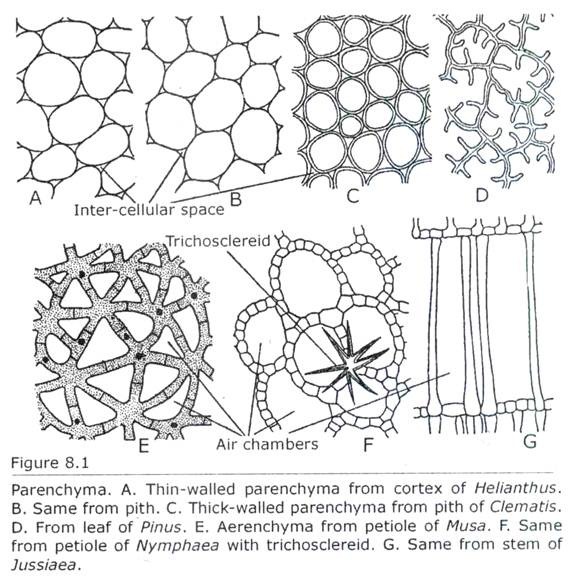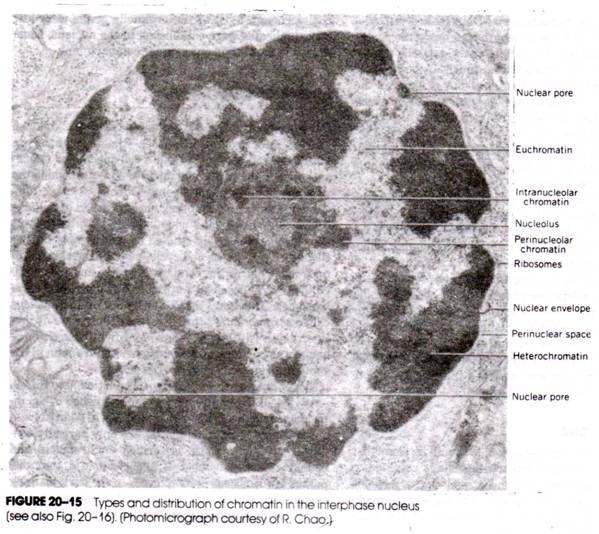ADVERTISEMENTS:
Parenchyma (Figs. 8.1, 8.6) is a cell and tissue type in which the cells have only thin primary walls; the cells are unspecialized, lack the characteristic wall of collenchyma and the secondary walls of sclerenchyma; the cells have live nucleate protoplast concerned with various physiological activities in plants; the cells are meristematic, or permanent, simple homogeneous (i.e. composed of one type of cells only), fundamental or ground tissue upon which other simple and conducting tissues appear to be embedded.
i. Distribution:
Large portion of all plant organs are occupied by parenchyma. They occur in pith, cortex and pericycle of root and stem. They are also found in leaves as mesophyll tissue. They are also present in the fleshy parts of fruits and endosperm of seed. They also occur in the conducting tissues as xylem and phloem parenchyma. The innermost layer of periderm phelloderm is also composed of parenchyma.
ADVERTISEMENTS:
ii. Origin:
Parenchyma cells present in the primary plant body, i.e. pith and cortex, originates from the ground meristem. Procambium and cambium give rise to xylem and phloem parenchyma of the primary and secondary conducting tissues respectively. Phelloderm originates from phellogen. In leaves, protoderm and ground meristem give rise to parenchymatous epidermis and mesophyll respectively.
iii. Shape:
Isolated parenchyma cells grown in culture media are spherical. In cell aggregates, they are polygonal due to contact with other cells. Fourteen sided polyhedral cells are most common, although cells with 12, 13, and 15, 16 or fewer are found. The other most common shapes are elongate (e.g., mesophyll tissue of Lilium leaf), stellate (e.g. stem of Scirpus and Juncus), inner wall protuberated (e.g. phloem transfer cell of Sherardia leaf) etc.
ADVERTISEMENTS:
iv. Arrangement:
Mature parenchyma tissues may be compactly set without any intercellular spaces. Ex. endosperm tissue of seeds. They may also be arranged loosely so that well developed intercellular spaces are present between them. Ex. stems and leaves of hydrophytes.
v. Structure and content:
Parenchyma cells usually have primary walls (e.g., storage and chlorophyllous parenchyma). The storage parenchyma cells of endosperm of Phoenix, Asparagus have very thick walls. The thickness of wall is due to the deposition of hemicellulose.
Usually parenchyma cells contain living protoplast with single or numerous vacuoles. They may also contain leucoplasts, chloroplasts etc. (chloroplast containing parenchyma cells are termed as chlorenchyma). Various carbohydrates, nitrogenous and fatty substances are found in the cell sap of parenchyma. The parenchyma cells of the roots of sugar beet and the bulb scales of onion contain amides, proteins, sugars etc. in their cell sap.
The cotyledon of many leguminous plants contains protein and starch in their parenchyma cells. The parenchymatous endosperm of Ricinus communis contains protein and oils. Protein and starch are present in the parenchyma of potato tuber. Starch is present in the parenchyma of endosperm, tubers, cortex, fruits, xylem and phloem etc. In the parenchyma of storage organs and succulent, water is present.
ADVERTISEMENTS:
Tannins are also found in many parenchyma cells. Some parenchyma cells, termed idioblasts, which markedly differ in size, content and function than the neighbouring cells, may contain resinous substances (e.g. Rubiaceae, Rutaceae etc.), mucilaginous substances (e.g. Tiliaceae, Portulacaceae etc.), oily substances (e.g. Lauraceae) and the enzyme myrosinase (e.g. Cruciferae).
vi. Function:
(i) Living parenchyma cells are the site of all metabolic activities;
(ii) Chlorenchyma, i.e. parenchyma cells containing chloroplastids, can photosynthesize;
ADVERTISEMENTS:
(iii) Storage parenchyma stores different reserve materials;
(iv) Parenchyma cells present in conducting tissues, i.e. xylem and phloem parenchyma help in the movement of water and solutes;
(v) Aerenchyma, i.e. parenchyma cells present surrounding the air spaces in aquatic plants help in aeration, gaseous exchange and add buoyancy which helps in floating;
(vi) Meristematic parenchyma has the power of cell division and thus helps in healing up of wounds and regeneration;
ADVERTISEMENTS:
(vii) Transfer cells help in short distance transport of solutes;
(viii) The thick cell wall in Asparagus etc. due to the presence of hemicellulose, serves as reserve food which is utilized during germination;
(ix) Epidermal parenchyma cells with their cutinised peripheral walls of different plant organs help in protection; and
(x) the seedlings and some hydrophytes gain mechanical rigidity from turgid parenchyma cells.


